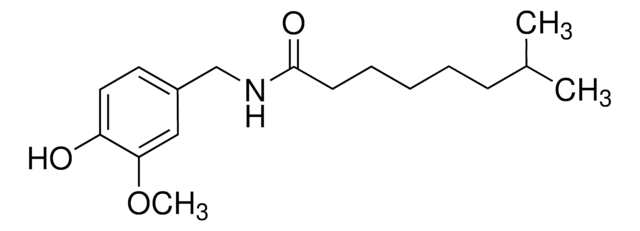Wichtige Dokumente
03813
Dihydrocapsaicin
analytical standard
Synonym(e):
6,7-Dihydrocapsaicin, 8-Methyl-nonansäure-vanillylamid, N-[(4-Hydroxy-3-methoxy-phenyl)-methyl]-8-methyl-nonenamid
Größe auswählen
About This Item
Empfohlene Produkte
Qualität
analytical standard
Qualitätsniveau
Assay
≥97.0% (HPLC)
Haltbarkeit
limited shelf life, expiry date on the label
Methode(n)
HPLC: suitable
gas chromatography (GC): suitable
Anwendung(en)
cleaning products
cosmetics
flavors and fragrances
food and beverages
personal care
Format
neat
Lagertemp.
2-8°C
SMILES String
COc1cc(CNC(=O)CCCCCCC(C)C)ccc1O
InChI
1S/C18H29NO3/c1-14(2)8-6-4-5-7-9-18(21)19-13-15-10-11-16(20)17(12-15)22-3/h10-12,14,20H,4-9,13H2,1-3H3,(H,19,21)
InChIKey
XJQPQKLURWNAAH-UHFFFAOYSA-N
Suchen Sie nach ähnlichen Produkten? Aufrufen Leitfaden zum Produktvergleich
Allgemeine Beschreibung
Anwendung
It may be used as a reference standard for the determination of dihydrocapsaicin in Capsicum fruit samples by HPLC equipped with a Surveyor photodiode array (PDA) detector[4] and in rat plasma by HPLC-triple quadrupole MS with electrospray ionization (ESI) in selected reaction monitoring (SRM) mode.[5]
Biochem./physiol. Wirkung
Verlinkung
Signalwort
Danger
H-Sätze
Gefahreneinstufungen
Acute Tox. 2 Oral - Eye Irrit. 2 - Skin Irrit. 2 - STOT SE 3
Zielorgane
Respiratory system
Lagerklassenschlüssel
6.1A - Combustible acute toxic Cat. 1 and 2 / very toxic hazardous materials
WGK
WGK 3
Flammpunkt (°F)
Not applicable
Flammpunkt (°C)
Not applicable
Hier finden Sie alle aktuellen Versionen:
Besitzen Sie dieses Produkt bereits?
In der Dokumentenbibliothek finden Sie die Dokumentation zu den Produkten, die Sie kürzlich erworben haben.
Kunden haben sich ebenfalls angesehen
Active Filters
Unser Team von Wissenschaftlern verfügt über Erfahrung in allen Forschungsbereichen einschließlich Life Science, Materialwissenschaften, chemischer Synthese, Chromatographie, Analytik und vielen mehr..
Setzen Sie sich mit dem technischen Dienst in Verbindung.







